英语国家概况New_Zealand
- 格式:ppt
- 大小:3.64 MB
- 文档页数:29
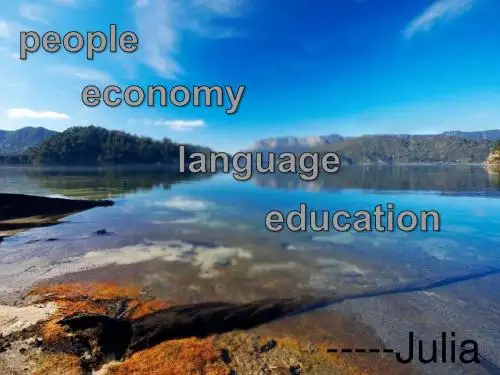
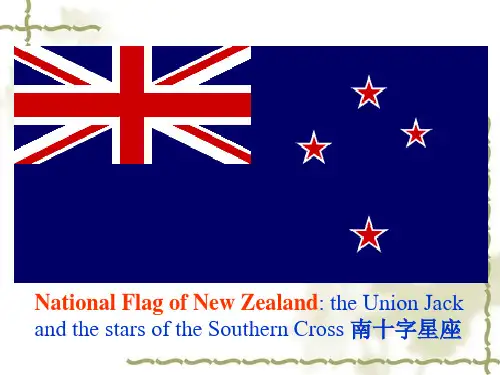
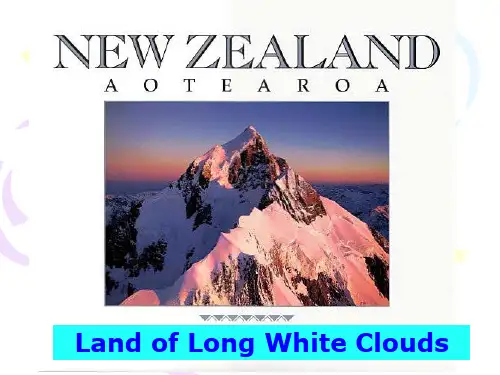
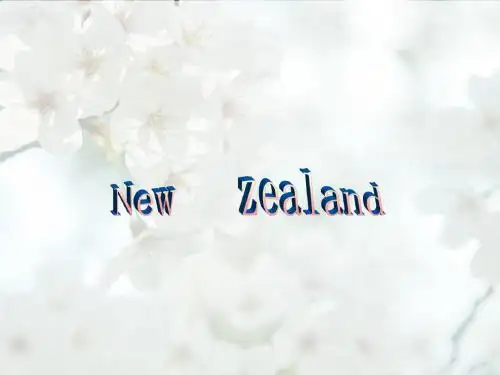
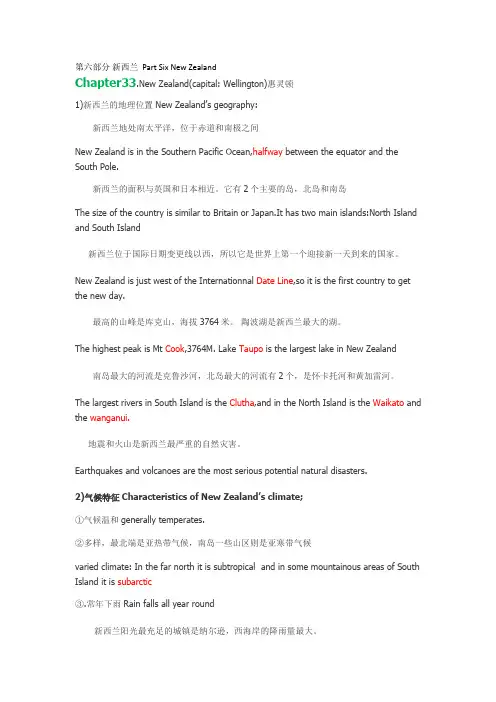
第六部分新西兰 Part Six New ZealandChapter33.New Zealand(capital: Wellington)惠灵顿1)新西兰的地理位置New Zealand’s geography:新西兰地处南太平洋,位于赤道和南极之间New Zealand is in the Southern Pacific Ocean,halfway between the equator and the South Pole.新西兰的面积与英国和日本相近。
它有2个主要的岛,北岛和南岛The size of the country is similar to Britain or Japan.It has two main islands:North Island and South Island新西兰位于国际日期变更线以西,所以它是世界上第一个迎接新一天到来的国家。
New Zealand is just west of the Internationnal Date Line,so it is the first country to get the new day.最高的山峰是库克山,海拔3764米。
陶波湖是新西兰最大的湖。
The highest peak is Mt Cook,3764M. Lake Taupo is the largest lake in New Zealand 南岛最大的河流是克鲁沙河,北岛最大的河流有2个,是怀卡托河和黄加雷河。
The largest rivers in South Island is the Clutha,and in the North Island is the Waikato and the wanganui.地震和火山是新西兰最严重的自然灾害。
Earthquakes and volcanoes are the most serious potential natural disasters.2)气候特征Characteristics of New Zealand’s climate;①气候温和generally temperates.②多样,最北端是亚热带气候,南岛一些山区则是亚寒带气候varied climate: In the far north it is subtropical and in some mountainous areas of South Island it is subarctic③.常年下雨Rain falls all year round新西兰阳光最充足的城镇是纳尔逊,西海岸的降雨量最大。
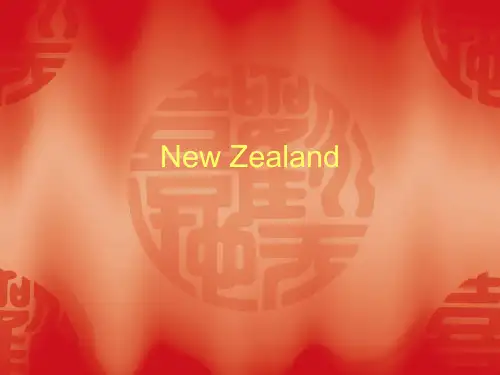
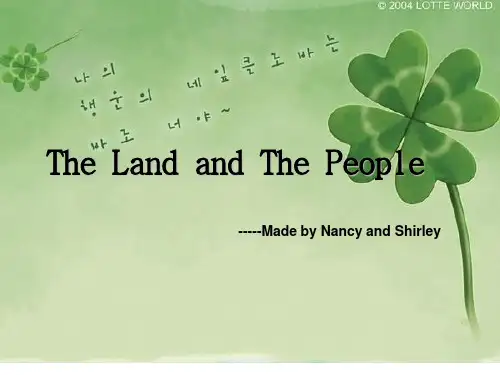
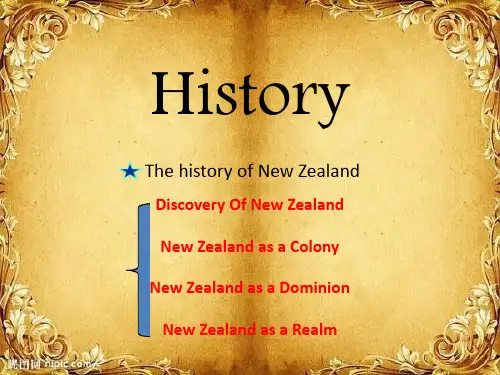
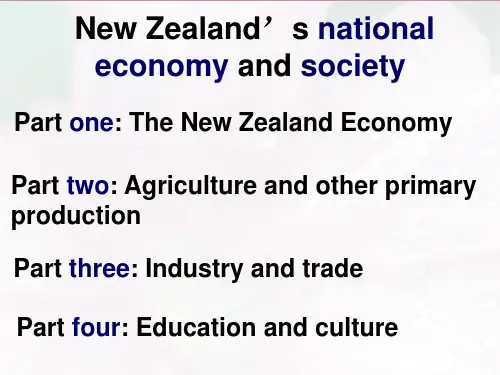
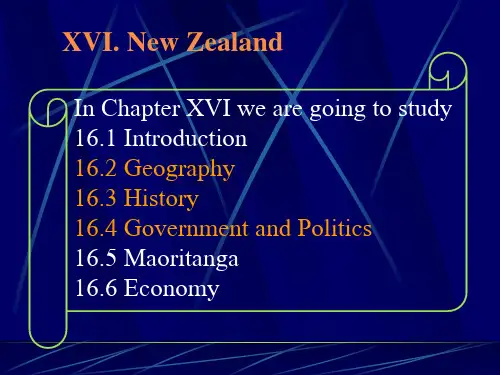
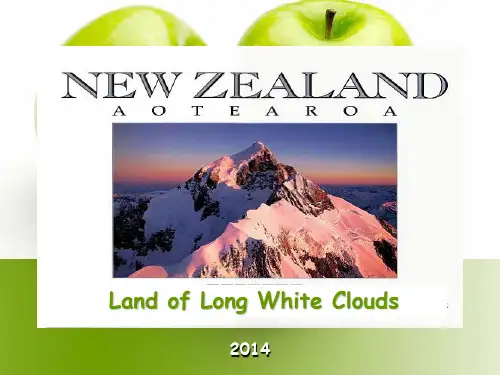
New Zealand / AotearoaSymbolsFlag∙The Union flag is in the top cornero Shows loyalty to Britain∙Southern Crosso A constellation seen in the Southern hemisphereNational Anthem∙“God Save the Queen”∙“God Defend New Zealand”o Both in English and MaoriNational Symbol∙The Kiwi – a flightless birdThe Land and the PeopleLocated in the Pacific OceanNorth Island∙Auckland – the largest city∙Wellington – the capital city∙There are many volcanoes on the island∙There are four volcanic mountainso Mount Egmont – most famouso Mount Ruapehu – the highest mountaino Mount Ngauruhoe – most activeo Mount Tonngariro – smallest mountain∙Swift rivers∙Hot springs∙Craters∙Energyo Geothermalo Hydro-electricSouth Island∙The most impressive mountains∙Glacierso Form lakes and riversClimate∙Mild temperatures∙High rainfall∙Many hours of sunshine∙The mountains influence the weathero Western side is very weto Eastern side is very dryPlants and Animals∙Geographic isolation and weather has led to the evolution of unique species only found on New Zealand!∙Almost no native mammals∙An abundance of different birds∙ A diversity of marine life∙The Kiwi – the National Symbol of NZ∙Kakapo – worlds largest parrot∙Tuatara – only beak-headed reptile∙Hector’s dolphinso The world’s largest dolphinso Only found in New ZealandPeople∙Population – 4.24 million peopleo¾ live on the North Islando85.4% live in urban areaso80% are of mixed European descent▪English, Scottish, Irish, German, etc.∙Maorio Largest non-European group (15%)o Original inhabitants (around 1100)o Polynesian∙Official Languageso English and Maori∙No state religion (freedom of religion)o40% have no religious affiliation▪Number is growing∙Dominate religion is Christianityo In declineHistory and the PresentMaori∙Descendants from the first Polynesian settlers around 1000AD∙Named the land AotearoaEuropean∙Dutch explorer Abel Tasman was the first European to discover NZ in 1642∙British explorer Captain James Cook mapped the island in 1796∙Newcomers were called Pakeha by the Maori∙The Pakeha were missionaries, traders, whalers, and sealersTreaty of Waitangi∙Attempt to ease tensions between the Maori and the colonists∙Signed in 1840∙The Maori chiefs give the British Queen governance of the islands∙The Queen’s representatives promise Maori ownership of the ir land, forests and fisheries ∙And gave the Maori the rights of British citizens∙Waitangi Day, New Zealand’s national day1840∙Britain establish first settlement at Wellington∙Land wars break out∙British ignore the Treaty and take land from the Maori∙By 1890, Maori own less than 1/6of New ZealandThe growth of a nation∙New Zealand Constitution Acto Establishes an independent government in 1852o General assemblyo Legislative councilo Elected house of representatives∙New Zealand officially becomes a dominion in 1907Late 19th Century∙Economic growtho The discovery of goldo Economy based on agricultureo Overseas trade in wool, meat, and dairy∙Progressive reformso1st country to allow women to vote in 1983o1st country to provide a pension to elderly people in 1898Modernization∙Full independence from Britain in 1947∙Economy continues to be based on agriculture∙Electoral reforms in 1993∙Minority parties are given better representation in parliamentRecreation∙Sportso British sports like rugby, cricket, netballo Unique geography makes skiing, hiking, skydiving, swimming, and fishing popular.∙Spend time in summer homes called “bachs” or “cribs”Maoritanga∙Rich and varied traditions of the Maori people∙Based on cooperation, loyalty, pride, and respect∙Maori are the official host people of New Zealand。
Chapter 34 New Zealand TodayThe population of New Zealand is 3.5 million. Approximately大约10 % are Maori, or part Maori. In spite of 尽管New Zealand's dependence on 依赖agriculture, most people live in towns and cities. About 55 % live in the seven urban centres of Auckland奥克兰, Wellington惠灵顿, Christchurch克赖斯特彻奇, Dunedin达尼丁, Hamilton哈密尔顿, Palmerston North北帕默斯顿and Napier-Hastings 纳皮尔——哈斯廷斯. The populations of the four main centres are Auckland 890,000, Wellington 330,000, Christchurch 310,000, Dunedin 110,000.新西兰的人口350万。
大约10%的人为毛利人或有部分毛利血统的人。
尽管新西兰依赖于农业,但大多数人还是居住在城镇和城市里。
大约55%的人住在七个大城市中:奥克兰、惠灵顿、克赖斯特彻奇、达尼丁、哈密尔顿,北帕默斯顿和纳皮尔——哈斯廷斯。
四个主要城市的人口分别为:奥克兰,89 O.000人;惠灵顿,330,000人;克赖斯特彻奇,310,000人;达尼丁,11 O.000人Nearly three fourths 3/4of the people live in North Island, with over 50% of New Zealanders living north of Hamilton. Reasons for this uneven distribution分布不均are the milder 更暖climate in the north, the expansion膨胀of North Island industries and the availability适合于of land suitable for specialized farming.特殊耕作近3/4的人住在北岛,50%的新西兰人住在哈密尔顿以北。